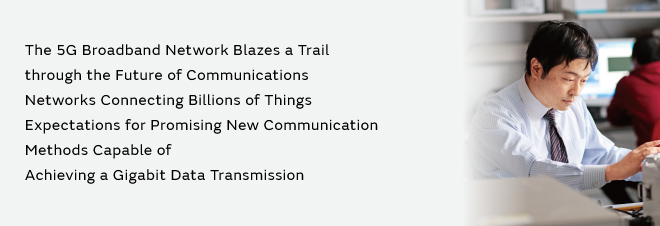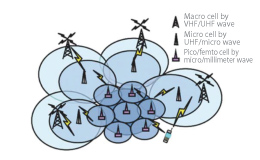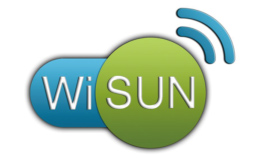
Dr. Hiroshi HARADA, Professor
Dept. of Communications and Computer Engineering Graduate School of Informatics Kyoto University
He joined the Communications Research Laboratory (currently the National Institute of Information and Communications Technology, or NICT) under the Ministry of Posts and Telecommunications in 1995. Since then, he has been engaged in the research and development as well as in the standardization of communications technologies in the field of digital signal processing mobile communications, software defined radio, cognitive radio, and wireless smart metering. He was a postdoctoral researcher at Delft University of Technology in the Netherlands from 1996-1997. He served on the board of directors of Wireless Innovation Forum (formerly SDR Forum) , and currently serves on the board of directors of WhiteSpace Alliance, Dynamic Spectrum Alliance and Wi-SUN® Alliance. He is the co-chair of the board of directors of Wi-SUN® Alliance. He is also the chair of the IEEE Dyspan Standards Committee (formerly IEEE 1900) and the vice chair of the Global Alliances as well as the International Standardization Committees of IEEE 802.15.4g, IEEE 1900.4, IEEE 802.15.4m, and TIA TR-51. He has been a professor of the Department of Communications and Computer Engineering of the Graduate School of Informatics of Kyoto University since 2014. He received an achievement award and became a fellow of the IEICE (Institute of Electronics, Information and Communication Engineers) in 2006 and 2009 respectively. He was a recipient of the MEXT (Ministry of Education, Culture, Sports, Science and Technology) Minister’s Award in Science and Technology as well as the MIC (Ministry of Internal Affairs and Communications) Minister’s Award of the Cabinet Office Persons of Merit Award in Industry-Academia-Government Collaboration in 2014.
His research focuses on the fifth-generation mobile communications system, which provides the next-generation wireless broadband networks that connect people. His research also includes the networks connecting a hundred million to a billion things. A challenge in his research is to find and develop new communication methods and protocols that will provide better connectivity to a greater number of people and things. He values collaboration with industry. He clearly defines the roles of industry, and clearly pictures how universities should be. His untiring pragmatic approach in research and development will impact the future of network society.
A Gigabit Data Transmission
Expectations for the 5G Broadband Network
5G, or the fifth-generation mobile communications system, under research and development today is the name given to the next-generation mobile communications standards beyond 4G LTE. The data transmission rate that 5G aims to accomplish in mobile telephone networks is on the order of gigabit, which is a more than hundred- to thousand-fold increase in speed when compared with the standard transmission rate today. The current goal is to launch the new 5G service in 2020, which is not an easy target as it requires efforts in both software and hardware.
The data communication does not always require gigabit data transmission in both uplink and downlink directions. Lower frequency may be used for the transmission of voice, whereas higher frequency may be used for the transmission of gigabit data. There are two kinds of information: control plane (CP) information, which helps the transmission of “information,” and user plane (UP) information, which is the actual contents of the information to be transmitted. While a user is in a lower frequency area, only his or her CP information may be transmitted because the CP information needs traffic for both uplink and downlink. When the user enters a higher frequency area, a volume of UP information may be transmitted using only downlink traffic. This kind of technology that takes advantage of using multiple frequencies is called ultra carrier aggregation. The objective of the research team led by Professor Harada is to find unused spaces in currently used frequency bands, and combine them to accomplish a gigabit data transmission in the aggregate.
Find White Spaces in Frequency Bands and Put Data in Them for Transmission
Technologies that are necessary to realize 5G are one to find white spaces, or unused frequency bands and another to put data in such spaces for transmission. Unused spaces may be scanned using measuring technologies such as a spectrum analyzer, or provided from cloud storage as a database prepared in advance. Information must be sent in an altered form that can be fitted into the spaces. Matching can be accomplished by adjusting the way the frequency range (bandwidth) is occupied by a signal, that is, by changing the signal spectrum. “Either by making hardware filters, or by developing a novel communication method. It will be the best if we have both. The former is a job for device makers like Murata, whereas the latter is a job for universities,” says Professor Harada.
A new approach that has started to produce results since around December 2015 is an application of a communication method called orthogonal frequency-division multiplexing, or OFDM, which smooths out discontinuities between signals by implementing a technique called windowing. This method will allow us to increase data transmission rate easily because the data compression only involves the signal processing. If this is not enough, filters may be introduced. The method will allow us to use the lower frequency range. Since the lower frequency band has a lower data transmission rate, only the data of CP information can be sent. When a user enters the high frequency band area, a large volume of data may be sent using unused bands.
The Fifth-Generation Broadband Mobile Communications System
Two outstanding issues that were not accomplished in 4G should be addressed in 5G. First, further enhancement of broadband mobile communications: more specifically, using four 5 MHz channels in the 4G LTE at most to achieve the maximum data transmission rate of about 300 Mbps for downlink and about 75 Mbps for uplink. Furthermore, bundling 20 of these channels at most to aim at the maximum data transmission rate of 3 Gbps for downlink and 1.5 Gbps for uplink. 5G will require a more than 10 times faster data transmission rate, or a rate on the order of 10 Gbps.

Schematic diagram of the 5G communications system
A Secret Strategy to Connect Communication Areas and Create a Seamless Network
Another area of research involves the use of higher frequency bands, such as 40 GHz and 60 GHz, which allow users to transmit a great deal of data. This approach, however, cannot cover a large geographical area, because the higher the frequency the higher the directionality of radio wave. The lower frequency wave has a range of about 2-5 km, whereas the higher frequency wave, such as millimeter wave, has a range of a few tens of meters. This fact makes practical application of a wireless service using only higher frequency bands seem improbable, especially if we consider the area of mobile communication in actual use, which includes the inside of buildings and moving trains.
Professor Harada has been studying a technique that would extend the communication range of radio waves in the higher frequency band, such as millimeter wave, on the order of 100 m. Professor Harada said, "The principle is simple. Install relay stations of wireless communications every 10 m and connect them with optical fibers. The "wired" optical fiber communications transmit data faster than wireless communications. Therefore, if the same signal is copied and dispatched simultaneously from a number of relay stations, a large virtual area of higher-frequency coverage can be created. The problem, though, is that, if the same signals are transmitted from mutually adjacent relay stations, radio waves (that is, signals) interfere with each other at the boundary regions. If we can establish a technology that can eliminate the interference and connect relay stations seamlessly, connectivity will be ensured in theory even if a user is moving in a car. "
An optical fiber is flexible, and less expensive. If the above-mentioned technology can be established, mobile communications in the higher frequency band will be a reality.
A challenge in the research is to develop a technology that suppresses noise and prevents interference in modulating electrical signals into optical signals or in demodulating vice versa. Through this kind of research, he has been trying to accomplish the wireless gigabit data transmission. In his laboratory, computational simulations using the computer-generated waveform models of signals have been conducted to examine the signal processing in the case of multiple reflections of the signals. Furthermore, an experiment using real-scale equipment is also scheduled to assess the simulation results. Professor Harada believes that he has done everything he could in digital signal processing. Spot white spaces and put signals in them; remove interference or multiple reflections with signal processing techniques. "Accumulation of these kinds of techniques is the most effective approach that universities can make. "
On the Order of a Hundred Million to a Billion
A Network Connecting a Huge Number of Things
The subjects of his research even include the network of control systems that connect things and process big data. Such systems have to have a long life; what he aspires to achieve is systems that can run for 10 years or so without replacement of the battery. The terminal nodes of the network of things are numerous, which can be on the order of a hundred million to a billion. The number is so huge that communities are created to facilitate communication. "The development of protocols used for this kind of signal processing is part of the mission of universities, " said Professor Harada, who tried to define the roles of the universities and device makers, "The electricity consumption should be reduced when the systems are idle and increased instantaneously when needed for operation. This task belongs to the hardware. Furthermore, making durable devices that will maintain acceptable performance for as long as 10 years and mass-producing them are part of the mission of device makers, such as Murata. "
Practical Application in Smart Electricity Meters
Further Anticipated in Disaster Prevention, Factories, Agriculture, and Healthcare
Its adoption in smart meters, which are the next-generation electricity meters, has brought attention to Wi-SUN®, the next-generation wireless communications standards, which comply with the specifications of the U.S. IEEE, in which Professor Harada serves as the vice chair. The standardization of the specifications has been led by Japan, which also took the initiative in establishing the global Wi-SUN® Alliance. Tokyo Electric Power Company, or TEPCO will adopt Wi-SUN® at all 27 million houses within its service area by the year 2020. Wi-SUN® is adopted as the communication method with the electronic device hub of each house for controlling power consumption at home. Other electric power companies also followed TEPCO to adopt Wi-SUN®, and a total of about 100 million Wi-SUN® devices are expected to be in operation in the future. Furthermore, Wi-SUN® is scheduled to be adopted in the smart meters for gas and water supply.
Wi-SUN® is also scheduled to be adopted in other fields, which include disaster prevention at slopes, where the precursors of slope collapses may be detected, and Industry 4.0, or the fourth industrial revolution, where all kinds of things and services are connected to production factories through the Internet. In agriculture, Wi-SUN® has already been adopted for the monitoring of high-grade mangos grown in greenhouses using heat from hot springs in Lake Mashu in Hokkaido. Another area where Wi-SUN® is to be adopted is the healthcare field.
"The number of sensors in a given sensor network has been thus far within the range of a few tens to a few hundreds of sensors. The smart meter is a sensor network that will involve at least a few tens of millions of sensors. We are entering into a new era of processing true big data. From now, we should couple this sensor network with artificial intelligence, or AI. If we can make an autonomous scheme for collecting data with the help of AI, I think that we will be able to create a novel market. Doing this in collaboration with the relevant authorities is one of the missions of universities, " said Professor Harada.
Network Society Is Like a High School Student
We Must Educate the People Who Will Create Our Future
In the opinion of Professor Harada, who is very familiar with network society, current communications technology, if expressed in human developmental stages, is like a high school student. Just as crying is the only expression that a human baby can use for communication, the first generation of communications is only capable of sending out information in a one-way traffic (broadcasting) . The second generation of communications is like a kindergartener or grade-schooler; that is, it is capable of communicating using sound. The third generation is like a middle schooler; it tries to control communication by differentiating voices from data, or vice versa. The fourth generation is like a high school student; it tries to comply with community regulations or standards to communicate. The fifth generation is like a college student; it realizes which frequencies to choose for communication and begins thinking and learning autonomously. When communications enters adulthood, it will be able to express wabisabi, which is a Japanese word meaning "finding the beauty in imperfection. " In this adulthood, there will be social codes including the manners or rules of respectful conduct, and the communications network will self-evaluate its compassion. This may sound like a far-fetched science-fiction movie, but it is a possible scenario of our predicted future.
Professor Harada came to Kyoto University two years ago. He will have his first graduate students soon. He is completely committed to deepening collaboration with industry and fostering students to become sought-after researchers by industry.
Wi-SUN® (Wireless Smart Utility Network)
One of the next-generation wireless communications standards adopted in the next-generation electricity meter “smart meter. ” The fact that Japan has been taking the initiative in standardizing the technical requirements has brought attention to the standards. In the last couple of years, there have been efforts to introduce a “smart” approach in metering utility services such as electricity, gas, and water supply, in order to improve the energy efficiency of society. Wi-SUN® is one of the powerful measures for that. The specifications are standardized by Japan’s National Institute of Information and Communications Technology (NICT) , Elster, Itron, Landis+Gyr, Silver Spring Networks, and others, and promoted by Wi-SUN® Alliance that was jointly established by the main contribution companies in the standard and module vendors, Murata and so on. The specifications of the physical layer are based on IEEE 802.15.4g, which is international specifications standardized by the Institute of Electrical and Electronics Engineers (IEEE) in the United States.

Wi-SUN® Alliance logo
Although Wi-SUN® (IEEE 802.15.4g) does not have a particularly high communication speed, it is characterized by its markedly low power consumption. One of the original architectures is a multi-hopping operation scheme, where the transmission of data is relayed between users’ terminals, like a water bucket relay, ultimately to deliver the data to remote locations. Although the communicable distance between terminals in Wi-SUN® is only about 500 m, the distance can be extended by relaying via a number of terminals, thereby delivering data to destinations that are a few kilometers or even a few tens of kilometers away from the sender. Also characteristic of Wi-SUN® is available choices of frequency bands and modulation schemes: Wi-SUN® service can use the frequency bands of 2.4 GHz and sub GHz (sub-gigahertz) and choose more than one modulation scheme. In Japan, 920 MHz band was allocated for Wi-SUN® service in 2012, which has allowed the practical application of smart meters. The advantage of sub-GHz band, as compared with the 2.4 GHz band often used in wireless LAN, is excellent transmission even if there are obstacles in its path. Also the band experiences little interference from other devices.